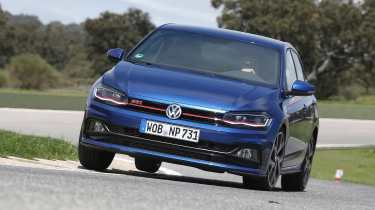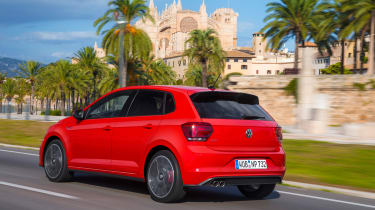2018 VW Polo GTI review – a polished performer, but it lacks flair
The new Polo GTI is a better car than its predecessor, but while it’s fast, composed and agile it lacks the crucial fun factor
The VW Polo GTI has long lived in the shadow of its illustrious Golf big brother. There’s always been a sense that the smaller car has been held back so that it doesn’t risk stealing the limelight of its distinguished sibling; and as a result it’s always been a step or two behind talented rivals such as the Ford Fiesta ST and Peugeot 208 GTi by Peugeot Sport.
Yet that’s all set to change with the new car, which has been given greater freedom to impress as a result of the Golf’s relentless push upmarket. Like all the latest Polo models, the GTI is based on the VW group’s excellent MQB scalable plaform that combines greater strength and rigidity with lower weight. Yet the big news is to be found under the bonnet, where the old 1.8-litre unit has been ditched in favour of the firm’s tried and tested EA888 turbocharged 2-litre – the same engine that’s used in the Golf. Here’s it’s been detuned to 197bhp, which is exactly the same figure as in the original MKV Golf GTI. This is promising.
Extra effort has been made on the Polo’s looks, too. Wherever you look there are plenty of clues that mark it out as part of the GTI family. Like the Golf there’s a distinctive red stripe that dissects the base of the grille and runs through into the headlamps, plus the front wings feature similar GTI logos. There’s also a large tailgate spoiler and twin exit exhaust, while 17-inch alloy wheels (the design is called ‘Milton Keynes’ – I kid you not) are standard and larger 18-inch rims are available as an option. The overall look is classy with an understated sportiness – just like the Golf in other words.
More reviews
In-depth reviews
Reviews
Inside the Polo plays a more playful hand. As you’d expect there’s the familiar checked trim for the seats and red stitching for the steering wheel, but a large red trim insert for the dashboard and centre console helps create a brighter and more youthful vibe. Quality is first rate, while additions such as the TFT dials help create an upmarket ambience that supermini rivals can’t match. The cabin is also remarkably roomy and the boot has a handy 351-litre capacity, which means the Polo is more practical than you’d expect from a pint-sized hot hatch.
Technical highlights
As we’ve already seen, the Polo GTI is built on the same MQB platform that underpins everything from the Golf to the huge Skoda Kodiaq SUV. This light and strong architecture allows the bodyshell of the five-door only Polo to be 28 per cent stiffer than its predecessors.
Mounted to this structure is an overhauled suspension system that comprises struts at the front and a torsion beam at the rear (the Golf’s multi-link system is to bulky and expensive for the smaller car). Compared to the standard car it has been lowered by 15mm and features springs that are 38 per cent stiffer at the front and 39 per cent firmer at the rear. There are also thicker anti-roll bars and uprated passive dampers. Also included is the brand’s XDS system, which attempts to mimic the traction-boosting effects of a limited-slip differential by tweaking the front brakes. Currently there’s no word on whether the Polo will be available with the Golf’s electronically controlled mechanical diff.
Drivers wanting even more focused dynamics can order the ‘Sport Select’ set up that features two-way adaptive dampers, a thicker front anti-roll bar and tougher steering arms and rear axle mountings. However, all versions of the GTI get configurable Driver Profile modes that allow you to choose between Eco, Normal, Comfort, Sport and Individual, with each subtly altering the steering weight, throttle response and gearshift strategy.
Early cars will only be available with VW’s six-speed twin-clutch gearbox, but a six-speed manual will be made available later in 2018.
Engine, transmission and 0-62mph time
With its large capacity 2-litre four-cylinder engine and relatively light and compact body the Polo hits on a classic hot hatch recipe. The EA888 engine will be familiar to owners of Golf GTI and R models, but here it’s tuned to deliver a respectable 197bhp and a healthy 236lb ft or torque. Crucially, maximum twist is generated at just 1500rpm, which should give the Polo the sort of effortless everyday acceleration that makes the larger Golf such an easy device to live with.
VW claims the DSG-equipped Polo will rattle off the 0-62mph sprint in just 6.7sec. Yet while it feels as fast as the numbers suggest when going all out, it never feels quite as quick as its torque figure and relatively low 1355kg kerbweight suggests. There’s plenty of muscle at low speeds, but the delivery goes a little flat in the mid-range – it feels as if the car’s potential is being deliberately reined in so as not to tread on the toes of the Golf – although this reluctance could also be explained by the tall intermediate gears.
Still, the EA888 relishes a workout and if you persist you’re reminded that it’s one of smoothest turbocharged fours out there, pulling cleanly, crisply and with a satisfyingly rorty rasp all the way to the redline.
Less impressive is the DSG twin-clutch gearbox. There’s nothing wrong with it technically (apart from some jerkiness when moving away it shifts smoothly in auto mode and swaps cogs with lightening quick speed when you use the steering wheel paddles), but its virtually seamless changes sap the sensation of speed, plus removes a crucial layer of driver interaction. We also found that it shifted up automatically when the engine hit its limiter, even in manual mode. The gear ratios also come in for criticism, particularly the chasm like gap between second and third – it was this gear in particular that the Polo felt like its mid-range pace was being blunted.
What’s it like to drive?
VW has made some big noises about the Polo GTI’s ‘playfulness’. With the larger Golf being pushed upmarket, the field is left clear for VW to deliver a more fun hot hatch. Certainly the Polo’s compact external dimensions (I say ‘compact’, it’s actually larger than a Golf MKIV in every dimension other than length), low weight and big engine should make for a genuinely entertaining package.
Initial impressions are good, because like its big brother the Polo benefits from slick and naturally weighted steering, almost perfect control weights and a taut yet controlled ride – on our Sport Select equipped car at least. Push harder and there’s strong bite from the front tyres and a definite sense that the rear axle is taking its share of the load, and on the smooth and snaking roads of our Spanish test route the VW felt planted and poised. Like the Golf, it covers ground quickly with an almost clinical precision. And therein lies the problem. Once you’ve tackled a few corners you’ve pretty much got the measure of the Polo. The steering is quick and precise but there’s only the bare minimum of feedback, while that grippy chassis doesn’t want to get expressive. Lifting the throttle will tighten the car’s line, but there’s no sense of the puppy-like agility you get in the 208 GTi.
The XDS ‘differential’ is also no substitute for the real thing. Torque vectoring means there’s plenty of grip when you turn in, but with the ESP in its halfway house Sport setting (you can’t turn the systems off completely) the inside wheel simply spins power away out of slower turns. Selecting Sport sharpens the throttle, adds artificial weight to the steering and fractionally firms up the dampers, but the Polo’s benign character remains. It’s an effective way of getting from A to B quickly, but not a thrilling one.
Take things easy and the GTI is a normal Polo, which means it’s comfortable, refined, roomy and easy to drive – few superminis are as simple to live with.
Price and rivals
At the time of writing VW hadn’t yet finalized pricing of the new Polo GTI. However, sources have hinted that the manual car (when it goes on sale late next year) will come in at a biscuit under £20,000, while the DSG car tested here will likely attract a £1500 premium. That compares well with the three-door only Peugeot 208 GTi, which tips the scales at £21,820 in standard guise and £23,550 in our preferred by Peugeot Sport trim. The Polo also promises to offer decent value and showroom appeal, with air-conditioning, heated seats, touchscreen infotainment and autonomous emergency braking all featuring. You can also add big car features such as the virtual TFT dials and LED headlamps.
So does the Polo shake off its understudy image and rise to the top? Well, yes and no. There’s no doubt the new car is faster and more composed device than its predecessor, while many buyers will love its mix of quality, refinement and effortless performance. Yet it still feels like its being held back so as not outshine the pricier Golf. As a result, it feels a little soft around the edges and doesn’t have involvement and serious intent of our current favourite, the Peugeot 208 GTi by Peugeot Sport. Now, if VW were to launch a Performance Pack version with more power, closely stacked ratios, a sharper handling balance and the Golf’s trick differential, then that might be another matter.







